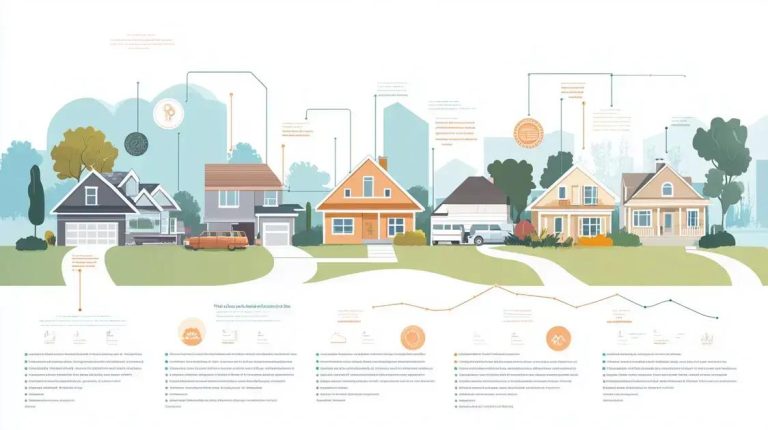In the world of financing, the choice between fixed vs. variable loan rates can significantly affect your budget.
By understanding the differences, you’ll be able to make informed decisions that align with your financial goals.
Understanding Fixed Loan Rates
Understanding fixed loan rates is essential for making smart financial choices.
A fixed loan rate means that the interest rate on your loan stays the same for the entire term of the loan.
This consistency can help you plan your monthly budget with ease, knowing that your payments won’t change over time.
One of the main benefits of a fixed loan rate is stability. When you lock in a rate, you are protected from fluctuations in interest rates. If market rates rise, your fixed-rate loan will remain unchanged, which can save you money over the long term.
Fixed loan rates can be ideal for those who prefer predictability in their finances.
They are often recommended for buyers who plan to stay in their home for many years, as the steady payments can provide peace of mind.
If you’re considering a loan, understanding fixed rates can help you make the best choice for your needs.
Understanding Variable Loan Rates
Understanding variable loan rates is important when choosing a loan. A variable loan rate can change over time, typically based on market conditions.
A variable interest rate loan, also known as an adjustable-rate loan, is one in which the interest rate can fluctuate over time based on market conditions.
This means your initial rate is often lower than that of a fixed-rate loan, making your early monthly payments more affordable.
This lower starting rate is one of the key advantages, especially for borrowers who plan to repay the loan quickly or expect interest rates to remain stable or decline.
If market rates decrease or stay low, you could benefit by paying less interest over time than with a fixed-rate loan.
This potential for short-term savings makes variable-rate loans attractive to some borrowers.
They are especially appealing to those with short-term financial goals or who want to optimize cash flow in the early years of the loan.
However, the flexibility of a variable rate comes with risks.
If market interest rates rise, your loan payments could increase significantly, making it harder to manage your budget.
In extreme cases, sharp increases in interest rates can lead to financial stress or even loan default.
Therefore, choosing a variable-rate loan requires careful consideration of your financial stability, risk tolerance, and long-term plans.
It’s important to assess whether you could still afford your payments if rates went up and whether the potential savings are worth the uncertainty.
Financial planning and consulting with a trusted advisor can help determine if this type of loan aligns with your overall goals.
Pros of Fixed Loan Rates

One of the biggest pros of fixed loan rates is their stability. When you choose a fixed rate, your interest remains constant throughout the loan period.
This means you know exactly what your monthly payments will be, making it easier to budget your finances without worrying about surprises.
Another advantage is protection from rising interest rates. In times of economic uncertainty, many people fear that rates will increase.
With a fixed loan rate, you are shielded from these changes.
Even if the market rates go up, your rate stays the same, potentially saving you money in the long run.
Lastly, fixed loan rates can provide peace of mind. Knowing that your payments will not change lets you feel more secure in your financial planning.
This can be especially beneficial for first-time home buyers who want to maintain control over their expenses.
Pros of Variable Loan Rates
One of the main pros of variable loan rates is their potential for lower initial interest rates.
At the start of a loan, these rates can be more attractive than fixed rates.
This can help borrowers save money in their early payments, making it easier to manage finances, especially for those on a tight budget.
Another benefit is that if market conditions improve, your interest rate may decrease.
This means your monthly payments can become lower, providing financial flexibility.
For people who are knowledgeable about market trends, this can be an excellent opportunity to save more on interest over the life of the loan.
Additionally, variable loan rates often offer more options regarding loan terms.
Lenders may provide various terms and conditions, allowing borrowers to customize their loans according to their needs.
This flexibility can be appealing for those looking to tailor their loan to their financial plans.
How to Choose Between Them
When deciding how to choose between fixed and variable loan rates, start by considering your financial situation.
Think about how long you plan to keep the loan. If you intend to stay in your home for many years, a fixed loan rate may provide the stability you need.
However, if you plan to move or refinance soon, a variable loan rate might be more cost-effective.
Next, assess your comfort level with risk. Fixed loan rates protect you from rising interest rates, offering predictable payments.
On the other hand, variable loan rates can change, meaning your payments may increase. If you prefer stability, a fixed rate could be the better option.
But if you’re open to potential savings and willing to take a chance, a variable rate might work for you.
Finally, research current market conditions. If interest rates are low, locking in a fixed rate can be smart.
Conversely, if rates are on the rise, a variable rate may offer short-term savings.
Speaking with a financial advisor can also help guide you in making the best choice for your situation.
When comparing fixed vs. variable loan rates, it’s important to know your financial goals.
A fixed loan rate provides predictable payments, which can make budgeting much easier.
If you prefer knowing exactly how much you will pay each month, this option might be best for you.
On the other hand, a variable loan rate can offer lower initial payments. If market rates remain favorable, you could save money in interest.
This option may appeal to those who have more flexibility in their budget and are willing to risk potential changes in their payments.
Ultimately, the choice depends on your personal situation.
Consider factors like how long you plan to stay in your home, your comfort with financial risk, and current market conditions.
Taking time to evaluate these factors will help you make a smart decision that fits your needs.





